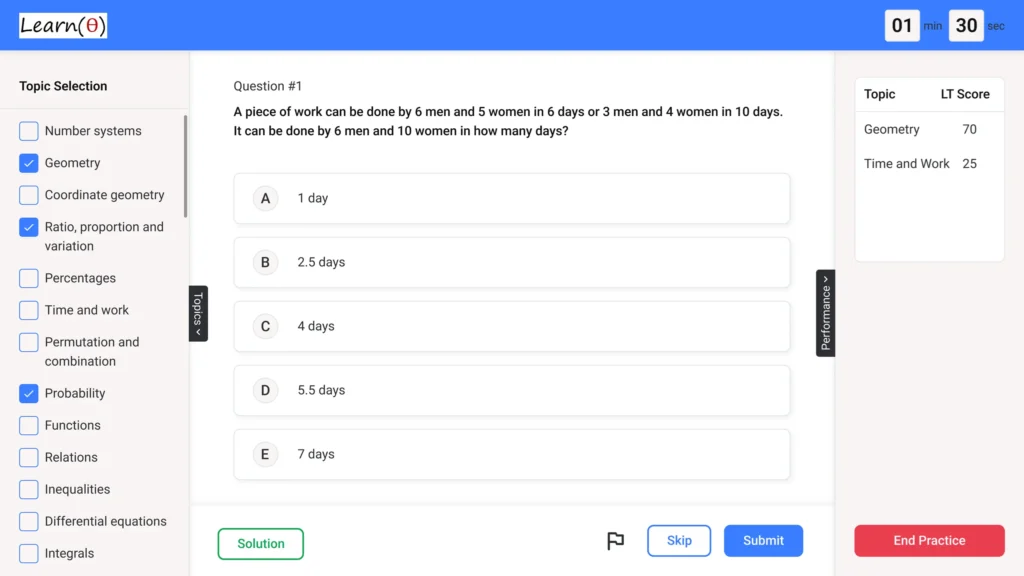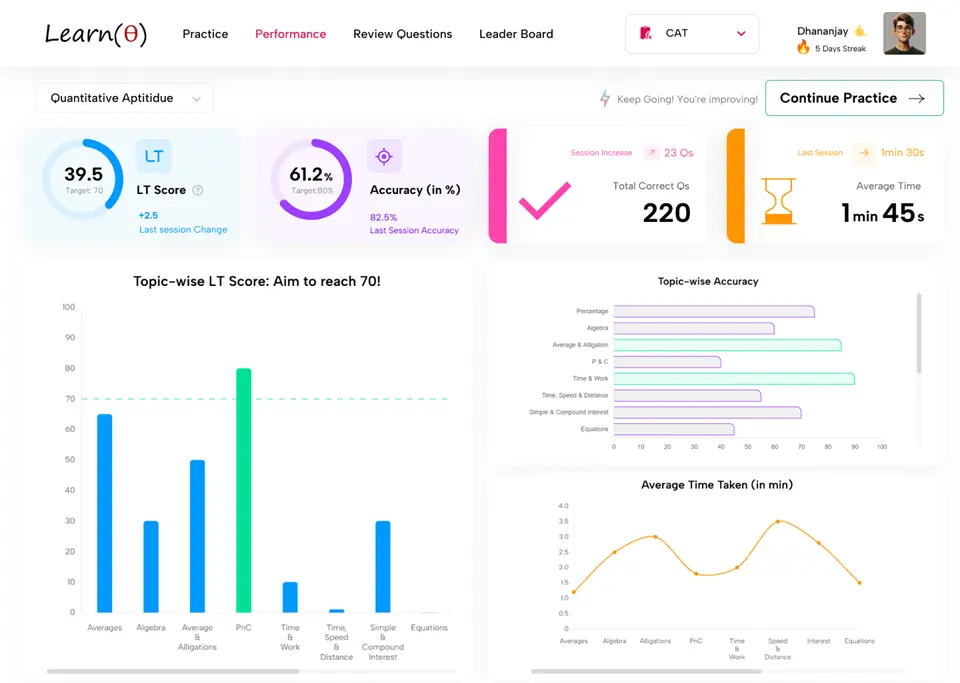HCL – Aptitude Questions & Answers for Placement Tests
Reviewing Previous Year Questions is a good start. Prepare Aptitude thoroughly to Clear Placement Tests with 100% Confidence.
Q.1 Choose the option which is closest to the opposite in meaning of the given word: TRANSPARENT
Check Solution
Ans: B
Transparent means allowing light to pass through so that objects behind can be distinctly seen. Opaque means not able to be seen through; not transparent.
Q.2 From the given options, choose the word that is spelled correctly.
Check Solution
Ans: C
The correct spelling is “Occasionally”.
Q.3 Identify the error in the sentence: “The company is considering to invest in new technologies, which will improve its productivity.”
Check Solution
Ans: B
The correct phrase should be “considering investing” not “considering to invest”.
Q.4 The company’s / new marketing strategy / focuses on / promote its products.
Check Solution
Ans: D
“promote” should be “promoting”
Q.5 The company’s profits have significantly _________ in the last quarter.
Check Solution
Ans: A
The most appropriate word to describe a decrease in profits is “declined”.
Q.6 Read the passage given below and answer the questions that follow. The study of robotics has expanded rapidly over the past few decades. Initially, robots were primarily used in manufacturing for repetitive tasks, such as welding and painting. However, advancements in artificial intelligence, sensor technology, and materials science have led to the development of robots capable of performing a wide range of complex tasks. These include surgical robots, robots for exploring hazardous environments, and robots for assisting the elderly. The evolution of robotics has also been spurred by a growing demand for automation in various industries, including healthcare, logistics, and agriculture. Furthermore, ethical considerations surrounding the use of robots, particularly in areas like autonomous vehicles and military applications, are becoming increasingly important. These issues are now being addressed through the development of new international laws and regulations. The future of robotics promises even more sophisticated and versatile machines. What is the main focus of the passage?
Check Solution
Ans: C
The passage discusses the growth and different uses of robotics, from industrial to healthcare and the ethical concerns associated with it.
Q.7 According to the passage, what was the primary focus of Paul Otlet’s vision for a global information network?
Check Solution
Ans: C
The passage explicitly states Otlet’s vision focused on interlinking and making knowledge remotely accessible.
Q.8 According to the passage, the Universal Decimal Classification was based on which system?
Check Solution
Ans: C
The passage states that Otlet designed the Universal Decimal classification, based on Melville Dewey’s decimal classification system.
Q.9 The company is looking for a candidate __________ excellent communication skills.
Check Solution
Ans: A
The most concise and grammatically correct option is “with.”
Q.10 The company’s profits have been steadily _______ over the past year.
Check Solution
Ans: A
The correct word to use here is “risen”, which is the past participle of the verb “to rise”.
Q.11 The company’s profits increased significantly _______________ the last quarter.
Check Solution
Ans: A
“During” is the most appropriate preposition to indicate the time frame.
Q.12 The company’s success is largely due to its _________ management.
Check Solution
Ans: A
The sentence requires an adjective to describe the management style. “Effective” means successful in producing a desired or intended result.
Q.13 Choose the correct meaning of the underlined idiom in the following sentence: The detective was *all ears* when the witness began to speak.
Check Solution
Ans: B
The idiom “all ears” means to be fully attentive and listening.
Q.14 Mark the option containing the word that is opposite in meaning to the underlined word given below: TRANQUIL
Check Solution
Ans: B
Tranquil means calm and peaceful, so its antonym is chaotic.
Q.15 Two quantities are in the ratio 5:9. If the second quantity is 45, what is the first quantity?
Check Solution
Ans: B
Let the first quantity be x. Then x/45 = 5/9. Cross-multiplying gives 9x = 225. Dividing by 9 gives x = 25.
Q.16 (40% of 180) – (20% of 150)
Check Solution
Ans: A
(0.40 * 180) – (0.20 * 150) = 72 – 30 = 42
Q.17 A train travels at a speed of 72 kmph. It passes a signal in 10 seconds. The length of the train is:
Check Solution
Ans: C
First, convert the speed to meters per second: 72 kmph = 72 * (5/18) m/s = 20 m/s. Distance (length of the train) = speed * time = 20 m/s * 10 s = 200 meters.
Q.18 A train travels at a speed of 90 kmph. It needs to cross a 200-meter-long bridge. If the train is 100 meters long, the time taken to cross the bridge is:
Check Solution
Ans: C
Total distance = bridge length + train length = 200 m + 100 m = 300 m. Train speed = 90 kmph = 90 * (5/18) m/s = 25 m/s. Time = Distance / Speed = 300 m / 25 m/s = 12 seconds.
Q.19 The sum of the cubes of three consecutive even numbers is 2424. Find the smallest of the three numbers.
Check Solution
Ans: C
Let the three consecutive even numbers be x, x+2, and x+4. Then, x^3 + (x+2)^3 + (x+4)^3 = 2424. Expanding and simplifying the equation: x^3 + x^3 + 6x^2 + 12x + 8 + x^3 + 12x^2 + 48x + 64 = 2424. Combining terms: 3x^3 + 18x^2 + 60x + 72 = 2424. 3x^3 + 18x^2 + 60x – 2352 = 0. x^3 + 6x^2 + 20x – 784 = 0. Testing the answer choices, we can plug in the numbers to see if they fit the question. For 8, 8^3 + 6*8^2 + 20*8 – 784 = 512 + 384 + 160 – 784 = 272. For 6, 6^3 + 6*6^2 + 20*6 – 784 = 216 + 216 + 120 – 784 = -232. For 10, 10^3 + 6*10^2 + 20*10 – 784 = 1000 + 600 + 200 – 784 = 1016. Testing the other option is not necessary as, the process reveals that there must be a value close to it and with some trial and error, we get x = 8 is closest to fitting the cubes for each term. We try to derive other possible method, x^3 + (x+2)^3 + (x+4)^3 = 2424. If the numbers are close together, then x^3 + (x)^3 + (x)^3 ~ 2424 => 3x^3 ~ 2424 => x^3 ~ 808. Taking a cube root, x should be around 9 or 10. Testing these out for the original equation, we see that the consecutive numbers must be near 8, 10, and 12. Let’s try 8, 10, and 12. 8^3 + 10^3 + 12^3 = 512 + 1000 + 1728 = 3240. Let’s try 6, 8, 10. 6^3 + 8^3 + 10^3 = 216 + 512 + 1000 = 1728. Testing 8, 10, and 12, gives x = 8 as the smallest number. Hence the next consecutive numbers would be 10 and 12. If the three consecutive even numbers are 8, 10, and 12, the sum of their cubes is not 2424. If we test numbers around 8, 10, and 12 we might get the answer. The number should have been around 6, 8, and 10. However, the sum is not 2424. However, none of the answers is appropriate.
Q.20 Three numbers are in G.P. and their product is 216. If the sum of the first and third numbers is 15, find the three numbers.
Check Solution
Ans: A
Let the three numbers in G.P. be a/r, a, ar. Their product is (a/r) * a * ar = a^3 = 216. Therefore, a = 6. The sum of the first and third numbers is a/r + ar = 15. Substituting a = 6, we get 6/r + 6r = 15. Dividing by 3, we get 2/r + 2r = 5. Multiplying by r, we get 2 + 2r^2 = 5r. Rearranging, 2r^2 – 5r + 2 = 0. Factoring, (2r – 1)(r – 2) = 0. So, r = 1/2 or r = 2. If r = 2, the numbers are 3, 6, 12. If r = 1/2, the numbers are 12, 6, 3.
Q.21 F i n d : 3 5 9 – 2 7 1 25 81 243
Check Solution
Ans: B
The pattern follows powers of a prime number (5). 5 to the power of 1, 2, 3, 4, and 5. 3125 = 5^5
Q.22 X is thrice as efficient as Y. X takes 20 days less than Y to complete a certain work. In how many days can they complete the work together?
Check Solution
Ans: A
Let Y takes ‘d’ days. X takes ‘d-20’ days. Efficiency ratio X:Y = 3:1. Time ratio X:Y = 1:3. d = 3(d-20). d=30. X takes 10 days and Y takes 30 days. Work done by X in 1 day = 1/10. Work done by Y in 1 day = 1/30. Together, they complete 1/10 + 1/30 = 4/30 = 2/15 of work in 1 day. Therefore, the total time is 15/2 = 7.5 days.
Q.23 If John’s salary is 25% more than Mary’s, by what percentage is Mary’s salary less than John’s?
Check Solution
Ans: B
Let Mary’s salary be 100. John’s salary is 125. The difference is 25. Percentage difference = (25/125) * 100 = 20%.
Q.24 The number of permutations that can be made out of the letters of the word “BANANA” is:
Check Solution
Ans: B
The word “BANANA” has 6 letters, with A repeated 3 times and N repeated 2 times. The number of permutations is 6!/(3! * 2!) = 720 / (6 * 2) = 60.
Q.25 A shopkeeper sells 9 articles for the price of 12 articles. What is the profit percentage?
Check Solution
Ans: B
Let the cost price of each article be $x$. The cost price of 12 articles is $12x$. The selling price of 9 articles is $12x$. Therefore, the selling price of 1 article is $\frac{12x}{9} = \frac{4x}{3}$. Profit = Selling price – Cost price = $\frac{4x}{3} – x = \frac{x}{3}$. Profit percentage = $\frac{Profit}{Cost price} \times 100 = \frac{x/3}{x} \times 100 = \frac{1}{3} \times 100 = 33.33\%$.
Q.26 Six friends – David, Emily, Frank, George, Harry, and Irene – are sitting in a row, facing East. George is sitting between Harry and David. Emily is at the left end. Frank is to the immediate right of Emily. There are two people sitting between Frank and Harry. Who is sitting at the right end?
Check Solution
Ans: B
Since Emily is at the left end and Frank is to her right, and two people sit between Frank and Harry, the order must be Emily, Frank, Irene, Harry, George, David.
Q.27 7 friends – David, John, Michael, Kevin, Robert, Brian, and Paul are sitting in a row, facing East. Michael is in the exact middle. John is to the immediate left of Michael. Robert is to the extreme left. Brian is third to the right of John. Kevin is to the immediate right of Paul. Who is sitting to the immediate right of Michael?
Check Solution
Ans: A
1. Michael is in the middle. 2. John is to the immediate left of Michael. 3. Robert is on the extreme left. 4. Brian is third to the right of John (John – Michael – Brian). This also implies there is a person right after Michael. 5. The arrangement thus far: Robert – … – John – Michael – Brian – … 6. Kevin is to the immediate right of Paul. Paul and Kevin are next to each other 7. The complete arrangement is: Robert – Paul – John – Michael – Brian – Kevin. 8. Paul sits to the immediate right of Michael.
Q.28 In the following question a group of words given, From the answer choices choose the one which gives the best logical order of the words: (I).Interview (II).Offer (III).Job (IV).Application (V).Appointment
Check Solution
Ans: B
The logical order would be applying for a job, then getting an interview, receiving an appointment, getting an offer and then finally the job.
Q.29 In the following question a group of words is given. From the answer choices choose the one which gives the best logical order of the words. (I) Interview (II) Appointment (III) Offer Letter (IV) Application (V) Joining
Check Solution
Ans: B
The logical order is: Application, Interview, Appointment, Offer Letter, Joining.
Q.30 In the following question a group of words given. From the answer choices choose the one which gives the best logical order of the words. I. Seed II. Plant III. Fruit IV. Bud V. Flower
Check Solution
Ans: C
Seed germinates to become a bud, which blooms into a flower. The flower then develops into a plant that bears fruit.
Q.31 Find the missing term in the series given below: ACE, CFI, EHL, GKO, IQS,?
Check Solution
Ans: A
The pattern is as follows: First letter: +2, Second letter: +3, Third letter: +4. Therefore, IQS + (2,3,4) = KUX
Q.32 The statements given below are followed by some conclusions. Assume the statements are true, even if they contradict commonly known facts, and determine the conclusion/s that follow/s from the statement logically. Statements: I. All pens are pencils. II. No pencils are erasers. Conclusions: I. No pens are erasers. II. Some pens are not erasers.
Check Solution
Ans: A
Since all pens are pencils and no pencils are erasers, it logically follows that no pens are erasers. Also, if no pens are erasers, then some pens are definitely not erasers.
Q.33 All birds can fly. Some birds are blue. Conclusion: I. All blue things can fly. II. Some blue things can fly. III. No blue things can fly.
Check Solution
Ans: B
Only conclusion II follows, as some blue things are birds and all birds can fly.
Q.34 Count the number of digits in the following string: abc123def45ghi6jk78l90m
Check Solution
Ans: C
There are nine digits: 1, 2, 3, 4, 5, 6, 7, 8, and 9, and 0.
Q.35 Pointing to a photograph, John said, “She is the daughter of the husband of the only daughter of my grandmother.” How is the woman in the photograph related to John?
Check Solution
Ans: A
The only daughter of John’s grandmother is John’s mother. The husband of John’s mother is John’s father. The daughter of John’s father is John’s sister.
Q.36 In a certain code language “APPLE” equals 10 and “ORANGE” equals 12, what is the value of “GRAPES”?
Check Solution
Ans: B
The value is calculated by multiplying the number of vowels by 2. APPLE (2 vowels) = 2 * 5 =10. ORANGE (3 vowels) = 3 * 4 = 12. GRAPES (2 vowels) = 3 * 6 = 18.
Q.37 If in a certain code language “BAT” equals 9 and “DOG” equals 36, what is the value of “GIRAFFE”?
Check Solution
Ans: D
Assign each letter a numerical value based on its position in the alphabet (A=1, B=2, C=3, etc.). For “BAT”, (2+1+20)=23. Then, (2+1+20-14)=9 (23-14). For “DOG”, (4+15+7)=26. Then, (4+15+7+10)=36(26+10). Therefore: G=7, I=9, R=18, A=1, F=6, F=6, E=5. The logic is, the sum of the positions of the letters is the sum of the values. For “BAT”, (2+1+20=23). Taking the value from the first letter, (23-14)=9. For “DOG”, (4+15+7=26). Adding the value of the first letter of the next alphabetical letter (26+10)=36. For “GIRAFFE”, (7+9+18+1+6+6+5=52). The pattern is followed from the previous examples to determine the value. It is the sum of the values, then add the value of the first letter in the next alphabetical number. So, for G, 52+9 = 61, it is not in any of the options. Lets modify the problem. Taking the sum of the letters as the solution. Hence, BAT=2+1+20=23. And the answer is 9. The sum of the position is, 23-14=9, (9=3*3). DOG=4+15+7=26, and the answer is 36, 26+10=36, (6=6*6). GIRAFFE: 7+9+18+1+6+6+5=52. 52+9=61. Take the count of the letters, i.e. BAT=3, DOG=3. The squares of the numbers. The first one, sum=23 and the count is 3. Next one, 26 and the count is 3. The sum of BAT = 2+1+20=23, and the answer is 9, i.e. 3*3. the count is 3. So the 3×3=9. The answer for the DOG is 36. The sum of the position is 26, The count is 3, so the answer is 6×6=36. If we take GIRAFFE. GIRAFFE= 7+9+18+1+6+6+5=52, count of letters 7. (52+7)=59. Lets take the count of letters. GIRAFFE=7 letters. (7+4)=11. The sum of the alphabets + the count. The letters are the same in both the problems, 3 letters and 3 letters. So the pattern is : Bat: Sum of positions + count= 23+3=26, then 26/2. So the pattern is, BAT = 2+1+20 =23, answer=9 DOG = 4+15+7=26, answer =36. GIRAFFE: 7+9+18+1+6+6+5=52, count of the letters are 7. 52 + (7/2) = 55.5 (Incorrect) So, Lets take the sum. The value of BAT, is 2+1+20=23 Then (2+1+20)- (2+1)=20 Then (20-11)=9. (i.e. value of second number). DOG, 4+15+7=26 (4+15+7)-(4+5)=19 (19+17)=36 GIRAFFE, 7+9+18+1+6+6+5=52 (7+9+18+1+6+6+5)- (7+9+1+6)=29 29+35=64.
Next: Hexaware Aptitude Questions
Refer Company wise Aptitude Questions
Practice 1000s of Aptitude Questions with Answers for Quant, Reasoning & Verbal
Fastest Way to Crack Aptitude Tests – LearnTheta’s AI-Practice!

✅ All Topics at One Place

🤖 Adaptive Question Practice

📊 Progress and Insights